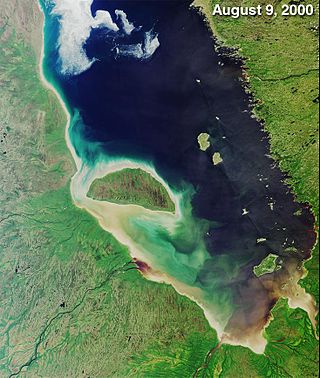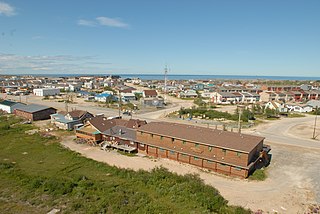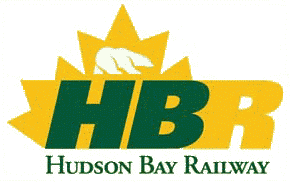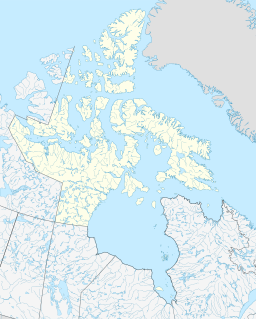
The Hudson's Bay Company is a Canadian retail business group. A fur trading business for much of its existence, it became the largest and oldest corporation in Canada, and now owns and operates retail stores across the country. The company's namesake business division is Hudson's Bay, commonly referred to as The Bay.

Hudson Bay, sometimes called Hudson's Bay, is a large body of saltwater in northeastern Canada with a surface area of 1,230,000 km2 (470,000 sq mi). It is located north of Ontario, west of Quebec, northeast of Manitoba, and southeast of Nunavut, but politically entirely part of Nunavut. It is an inland marginal sea of the Arctic Ocean. The Hudson Strait provides a connection between the Labrador Sea and the Atlantic Ocean in the northeast, while the Foxe Channel connects the Hudson Bay with the Arctic Ocean in the north. It drains a very large area, about 3,861,400 km2 (1,490,900 sq mi), that includes parts of southeastern Nunavut, Alberta, Saskatchewan, Ontario, Quebec, all of Manitoba, and parts of the U.S. states of North Dakota, South Dakota, Minnesota, and Montana. Hudson Bay's southern arm is called James Bay.

James Bay is a large body of water located on the southern end of Hudson Bay in Canada. It borders the provinces of Quebec and Ontario, and is politically part of Nunavut. Its largest island is Akimiski Island.

Hudson Strait in Nunavut links the Atlantic Ocean and the Labrador Sea to Hudson Bay in Canada. This strait lies between Baffin Island and Nunavik, with its eastern entrance marked by Cape Chidley in Newfoundland and Labrador and Nunavut and Resolution Island, off Baffin Island. The strait is about 750 km (470 mi) long with an average width of 125 km (78 mi), varying from 70 km (43 mi) at the eastern entrance to 240 km (150 mi) at Deception Bay.

Rupert's Land, or Prince Rupert's Land, was a territory in British North America which comprised the Hudson Bay drainage basin. The right to "sole trade and commerce" over Rupert's Land was granted to the Hudson's Bay Company (HBC), based at York Factory, effectively giving that company a commercial monopoly over the area. The territory operated for 200 years from 1670 to 1870. Its namesake was Prince Rupert of the Rhine, who was a nephew of King Charles I and the first governor of HBC. In December 1821, the HBC monopoly was extended from Rupert's Land to the Pacific coast.

Churchill is an Arctic port town in northern Manitoba, Canada, on the west shore of Hudson Bay, roughly 140 km (87 mi) from the Manitoba–Nunavut border. It is most famous for the many polar bears that move toward the shore from inland in the autumn, leading to the nickname "Polar Bear Capital of the World" and to the benefit of its burgeoning tourism industry.

Northwestern Ontario is a secondary region of Northern Ontario in the Canadian province of Ontario which lies north and west of Lake Superior and west of Hudson Bay and James Bay. It includes most of subarctic Ontario. Its western boundary is the Canadian province of Manitoba, which disputed Ontario's claim to the western part of the region. Ontario's right to Northwestern Ontario was determined by the Judicial Committee of the Privy Council in 1884 and confirmed by the Canada Act, 1889, of the Parliament of the United Kingdom. In 1912, the Parliament of Canada by the Ontario Boundaries Extension Act gave jurisdiction over the District of Patricia to Ontario, thereby extending the northern boundary of the province to Hudson Bay.

The Algoma Central Railway is a railway in Northern Ontario, Canada, that operates between Sault Ste. Marie and Hearst. It used to have a branch line to Wawa. The area served by the railway is sparsely populated, with few roads.

The barren ground shrew is a small shrew found in northern Canada west of Hudson Bay and in Alaska. At one time, this species was considered to be a subspecies of the similar cinereus shrew. It is similar in appearance and thought to be closely related to the Saint Lawrence Island shrew and Pribilof Island shrew.

Ungava Bay is a bay in northeastern Canada separating Nunavik from Baffin Island. Although not geographically apparent, it is considered to be a marginal sea of the Arctic Ocean for climatic reasons. The bay is roughly oval-shaped, about 260 kilometres (160 mi) at its widest point and about 320 kilometres (200 mi) in length; it has an area of approximately 50,000 km2 (19,000 sq mi). It is generally fairly shallow, under 150 metres (490 ft), though at its border with the Atlantic Ocean depths of almost 300 metres (980 ft) are reached.

Hudson Bay Railway is a Canadian short line railway operating over 1,300 kilometres (810 mi) of track in northeastern Saskatchewan and northern Manitoba.

The Hudson Bay drainage basin is the drainage basin in northern North America where surface water empties into the Hudson Bay and adjoining waters. Spanning an area of about 3,861,400 square kilometres (1,490,900 sq mi) and with a mean discharge of about 30,900 m3/s (1,090,000 cu ft/s), the basin is almost entirely within Canada. It encompasses parts of the Canadian Prairies, Central Canada, and Northern Canada. A small area of the basin is in the northern part of the Midwestern United States.

Jens Eriksen Munk was a Danish-Norwegian navigator and explorer. He entered into the service of King Christian IV of Denmark-Norway and is most noted for his attempts to find the Northwest Passage.
The Ottawa Islands are a group of currently uninhabited islands situated in the eastern edge of Canada's Hudson Bay. The group comprises 24 small islands, located at approximately 60N 80W. The main islands include Booth Island, Bronson Island, Eddy Island, Gilmour Island, J. Gordon Island, Pattee Island, and Perley Island. The highest point is on Gilmour Island, which rises to over 1,800 ft (550 m). Located a short distance off the northwest coast of Quebec's Ungava Peninsula, they, like the other coastal islands in Hudson Bay, were historically part of the Northwest Territories, and became Crown Land upon the creation of Nunavut in 1999. Nunavik Inuit have occupied these islands since time immemorial and gained constitutionally-protected harvest and access rights under the Nunavik Inuit Land Claim Agreement signed in 2007.

The Hudson Bay Lowlands is a vast wetland located between the Canadian Shield and southern shores of Hudson Bay and James Bay. Most of the area lies within the province of Ontario, with smaller portions reaching into Manitoba and Quebec. Many wide and slow-moving rivers flow through this area toward the saltwater of Hudson Bay: these include the Churchill, Nelson and Hayes in Manitoba, Severn, Fawn, Winisk, Asheweig, Ekwan, Attawapiskat, and Albany in Ontario, and the Harricana, Rupert and Eastmain in Quebec. This is the largest wetland in Canada, and one of the largest in the world. The region can be subdivided into three bands running roughly northwest to southeast: the Coastal Hudson Bay Lowland, Hudson Bay Lowland, and James Bay Lowland.

The Hudson Bay wolf is a subspecies of gray wolf native to the northern Kivalliq Region, including the northwestern coast of Hudson Bay in Canada. It was first classed as a distinct subspecies in 1941 by Edward Goldman, who described it as being a white colored, medium-sized subspecies similar to C. l. arctos, but with a flatter skull. This wolf is recognized as a subspecies of Canis lupus in the taxonomic authority Mammal Species of the World (2005).
Nevill Bay is a long and narrow waterway in the Kivalliq Region, Nunavut, Canada. It is located in northwestern Hudson Bay between Arviat and Whale Cove, approximately 12 km (7.5 mi) south of Tavani.
Mistake Bay is a waterway in the Kivalliq Region, Nunavut, Canada. It is located in northwestern Hudson Bay by the old mining settlement and trading post of Tavani. Mistake Bay, to the south of Wilson Bay, has numerous islands and shoals.
The Owl River is a river in the Hudson Bay drainage basin in census division 23 in Northern Manitoba, Canada. It flows from Fly Lake to Hudson Bay.















